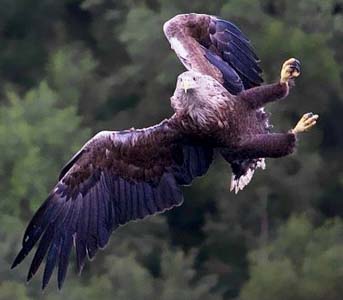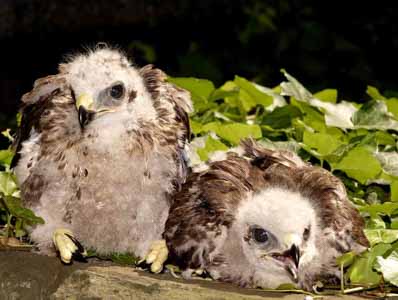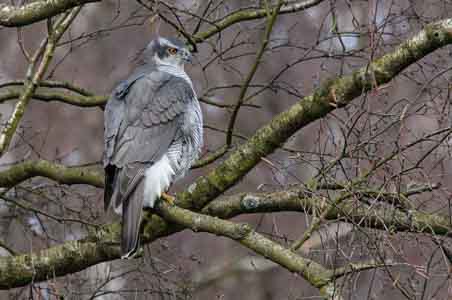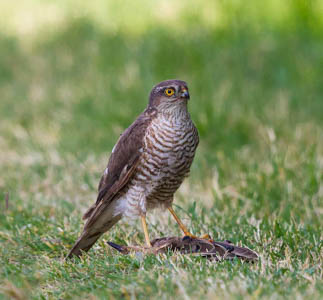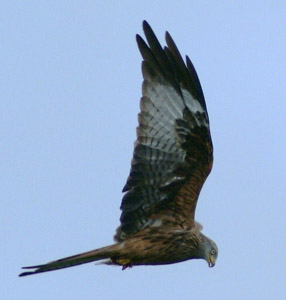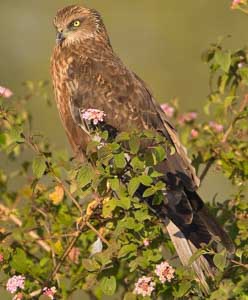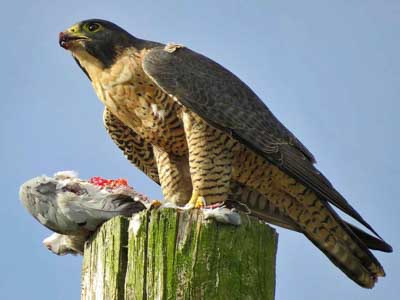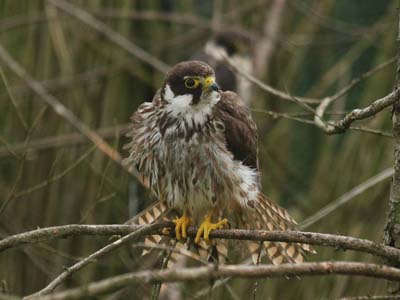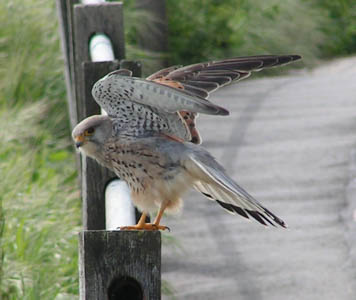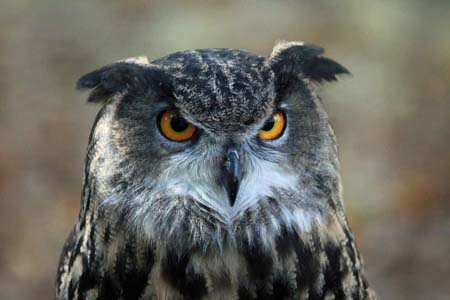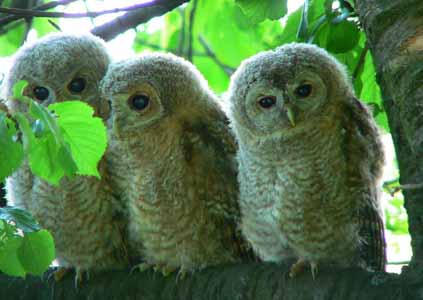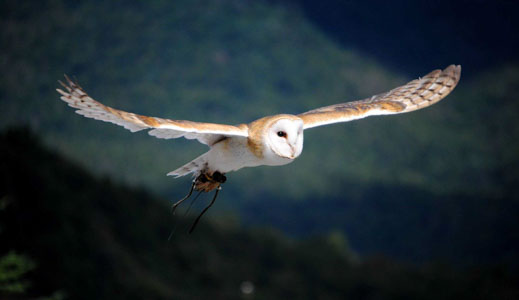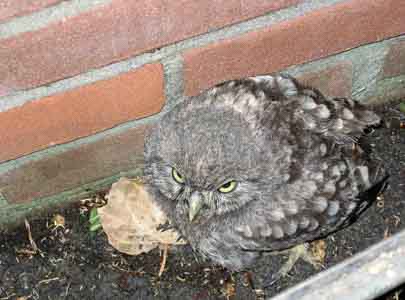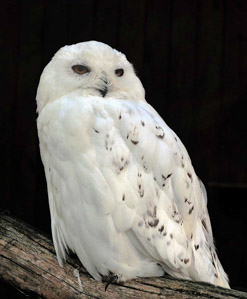Resident
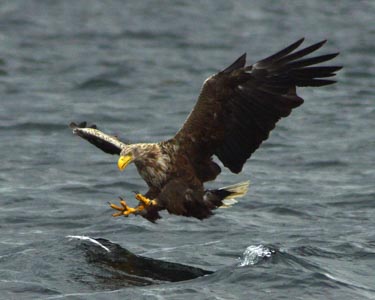
White-tailed eagle (Haliaeetus albicilla)
Length: 70-90cm
Wingspan: 200-240cm
UK pop.: 100+ pairs
The white-tailed sea eagle became extinct in Britain in the early 1900's. A successful re-introduction programme on the West Coast of Scotland has seen the numbers rise steadily since the 1970’s. The largest bird of prey in Britain, this eagle will snatch fish from the water. The white-tailed eagle will also hunt mammals and waterfowl, as well as eating carrion. The majority of the population in Britain is found only in the highlands and islands of the west of Scotland, with a few pairs around Fife and the glens of Angus. The white-tailed sea eagle will build its nest on rocky ledges and in large trees.
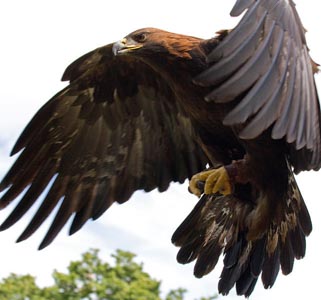
Golden eagle (Aquila chrysaetos)
Length: 75-88cm
Wingspan: 204-220cm
UK pop.: 500+ pairs
Found mainly in the North and West of Scotland, this majestic predator is the most adaptable and globally widespread of all the eagle species. The current breeding population is estimated at just over five hundred breeding pairs but slowly increasing. Large enough to take young red deer and roe-deer (there are reports of golden eagles killing adult red deer), the golden eagle will hunt rabbits, hare, and medium to large birds and is well known for eating carrion. The golden eagle will build its nest on protected rock ledges and large trees. The breeding pair may have as many as three or four alternative nest sites.
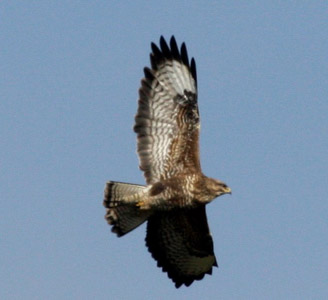
Common Buzzard (Buteo buteo)
Length: 51-57cm
Wingspan: 113-128cm
UK pop.: 70,000 pairs
Now the most common and most widespread UK bird of prey, they have recovered well from near extinction in the 1950's when myxomatosis in the rabbit population, their main diet, almost saw their demise. Remarkably adaptable, the buzzard has developed into a scavenger, often preferring road-kill and carrion to live prey. Buzzards will take small to medium mammals, birds, and even worms. Highly adaptable they are spotted in most environments including the edge of towns and cities, building its nest in large trees.
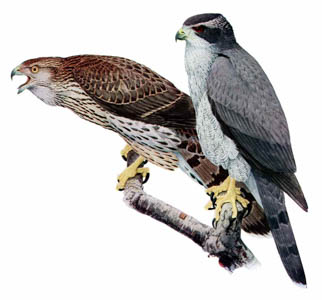
Goshawk (Accipiter gentilis)
Length: 48-62cm
Wingspan: 135-165cm
UK pop.: 400+ pairs
Hunted to extinction in the 19th century, the goshawk is a formidable and fearless hunter. Through the dedication of British falconers and availability of goshawks from Europe, the population has been re-established. A reputation for never giving up on prey, it will hunt anything from small birds to hares. Its broad wings and long flexible tail make it exceptionally fast whilst being highly manoeuvrable. A woodland dweller, the goshawk adapted well to large open coniferous forests, nesting in large trees.
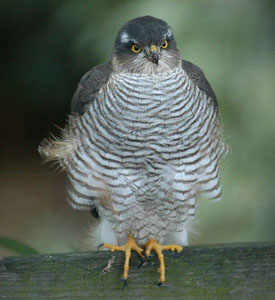
Sparrow-hawk (Accipiter nisus)
Length: 28-38cm
Wingspan: 55-70cm
UK pop.: 35,000 pairs
The sparrow-hawk has recovered well from the use of pesticides. So intent on the pursuit of prey, many are killed or injured colliding with trees or windows. Sparrow-hawks will hunt down birds up to their own size. Often blamed for the demise of song and garden birds, however, domestic cats and loss of habitat are the biggest culprits. Relatively widespread it can also be found in towns, cities. The sparrow-hawk will build its nest in tall trees.
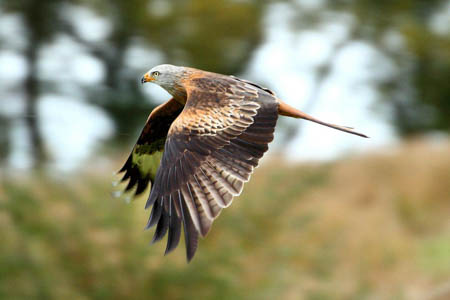
Red kite (Milvus milvus)
Length: 60-66cm
Wingspan: 175-195cm
UK pop.: 1,600 pairs
Persecution reduced red kite numbers to a dozen at the start of the 1900's. Re-introduction programmes, using imported birds from the Continent, have seen red kite numbers grow rapidly in Wales and selected areas of England and Scotland by the use of feeding stations. A notorious scavenger, they will eat anything. Red kites have been known to hunt small mammals and ground nesting birds. Easily identified by the distinctive "V" shaped tail. Red kites will nest in large deciduous trees.
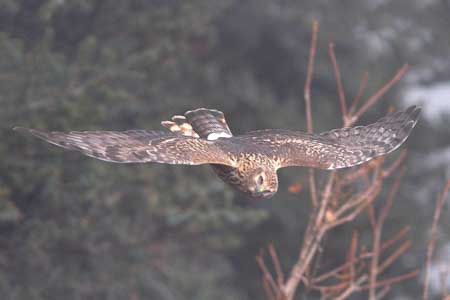
Hen harrier (Circus cyaneus)
Length: 44-52cm
Wingspan: 100-120cm
UK pop.: 500+ pairs
A ground nesting bird, the hen harrier suffered from persecution like many other birds of prey. Habitat loss contributed to the reduction in numbers. A striking difference between the dark brown female, and the grey male. The male is often seen transferring food to the female in flight during the breeding season. Usually habituating in Northern England and Scotland in open areas with low vegetation the can be seen more often in the South during the winter months. The hen harrier feeds on small mammals and ground nesting birds.
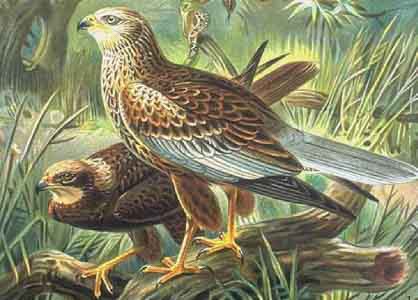
Marsh harrier (Circus aeruginous)
Length: 48-56cm
Wingspan: 115-130cm
UK pop.: 400 pairs
The natural habitat of the marsh harrier is bog, reed-beds and marshland. Land reclamation contributed to their extinction in the early 1900's. Protection of habitat, and the arrival of birds from the continent has helped numbers slowly increase since the 1930's. Marsh harriers are confined to Eastern and Southeast England mainly in reed-beds, the marsh harrier will feed on wading birds, ducks, and small mammals.
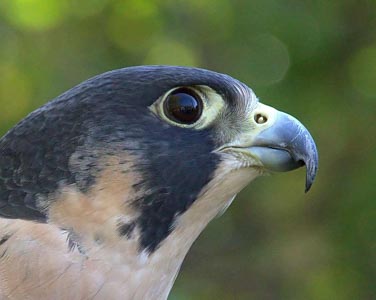
Peregrine falcon (Falco peregrinus)
Length: 39-50 cm
Wingspan: 95-115 cm
UK pop.: 1,500 pairs
For many years, the peregrine falcon suffered from direct persecution by man. During both world wars, a "shoot to kill" policy existed, as the peregrine was responsible for killing many carrier pigeons. Pesticides also contributed to their demise - introduced to kill off the birds feeding on crops, it was introduced into the food chain. Now, thanks to the dedication and hard work by the Falconry Community, their numbers have been re-established. The fastest creature on earth, reaching speeds in excess of 200 mph. Peregrines have adapted well to city life, nesting on tall buildings, and feeding on city dwelling pigeons. Feeding only on birds, the peregrine lays its eggs directly on to rocky ledges, or ledges on buildings.
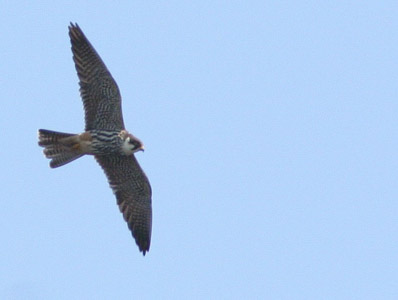
Hobby (Falco subbuteo)
Length: 28-36cm
Wingspan: 70-92cm
UK pop.: 1500 + pairs
Wintering in Africa the hobby can be seen in many parts of the UK for breeding especially the Southern and Eastern counties of England, Southeast Wales and Southeast Scotland during the summer months. This small, agile falcon, will prey on large insects, small birds, and even bats. Mostly seen at dusk, as the prey becomes active. The hobby does not build its own nest, but uses the abandoned nests of crows, magpies, or even squirrels.

Merlin (Falco columbarius)
Length: 25-30cm
Wingspan: 50-62cm
UK pop.: 1,100 pairs
The smallest of the british falcons, they are swift fliers and skilled hunters who specialize in preying on small birds in the size range of sparrows to quail. A heath and moorland dweller, the merlin has not suffered from historical persecution like other birds of prey. In winter they are more prevalent as Icelandic birds migrate south. The merlin will hunt small to medium sized birds, including wading birds. The merlin nests mainly in open moorland.
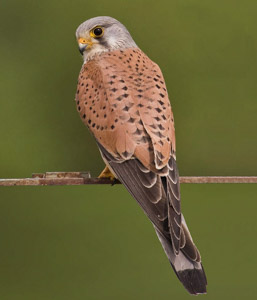
Kestrel (Falco tinunculus)
Length: 32-35cm
Wingspan: 71-80cm
UK pop.: 30,000 + pairs
The kestrel hunts in a totally unique way to other members of the falcon family. Often seen hovering by the side of roads and motorways, the kestrel follows the "ultra-violet reflecting", urine trail of voles and mice, looking for prey. Loss of habitat, such as hedgerows, due to modern farming methods, has forced this bird to seek new hunting grounds. In the 1970’s numbers were in decline, although they recently seen more often due to the change in hunting habits. The kestrel will nest in tree hollows, ground scrapes, hedges and abandoned nests.
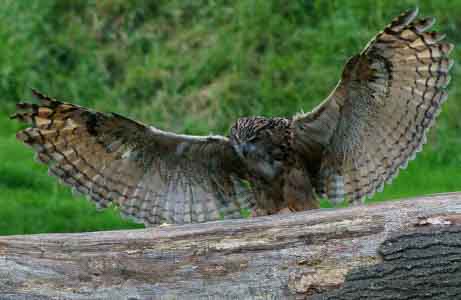
Eurasian eagle owl (Bubo bubo)
Length: 60 - 75 cm
Wingspan: 160 - 188 cm
UK pop.: 70 pairs
There is no evidence to confirm if the Eurasian (aka European) eagle owl was a resident of Britain in past centuries or not. However, there are reported to be some seventy breeding pairs. It is possible those birds are escapees, released illegally, or have arrived from the Continent. One of the largest owls in the world, this ferocious bird will dominate its territory, killing, or driving off, other birds of prey. Large enough to kill foxes and roe-deer, eagle owls will feed on rabbits, hares, and birds up to the size of buzzards. The eagle owl will nest in scrapes among rocks, the ideal habitat is abandoned quarries.
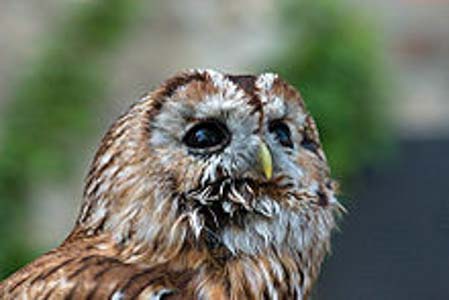
Tawny owl (Strix aluco)
Length: 37-39cm
Wingspan: 94-104cm
UK pop.: 50,000 pairs
The most numerous owl in Britain. A purely nocturnal, woodland dweller more often heard than seen with the classic "too-wit-too-woo". Widespread in England, Wales and Scotland this owl will feed on small mammals, birds, and even fish and frogs, nesting mainly in tree hollows.
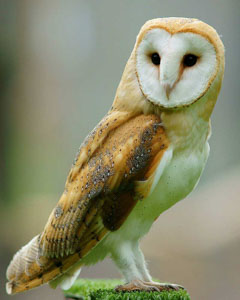
Barn owl (Tyto alba)
Length: 33-39cm
Wingspan: 80-95cm
UK pop.: 4,000 pairs
This once common owl is now endangered. Loss of habitat and nesting sites due to modern farming methods, combined with pesticides such as DDT in the 1950s and '60s, and the modern-day use rodenticides, have caused the numbers to drop rapidly to a dangerous level, estimated at around four thousand breeding pairs. Nocturnal, the barn owl will hunt by flying low, and slowly over the ground, quartering, using its remarkable hearing to search for voles, shrews, and mice. The barn owl will nest in hollow trees, buildings, and rock crevices. Over half the breeding population of barn owls in Britain now nest in man-made boxes.
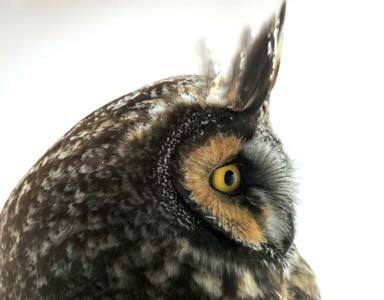
Long-eared owl (Asio otus)
Length: 35-37 cm
Wingspan: 84-95 cm
UK pop.: 3,500 pairs
A common, but secretive owl, hence, when combined with its nocturnal behaviour, difficult to accurately monitor. Another woodland dweller, well camouflaged, the long-eared owl's remarkable hearing makes it an extremely efficient hunter. Main diet consists of mice and voles. Very adaptable, this owl will turn to hunting small to medium sized birds in winter. The long-eared owl will nest in abandoned crow and magpie nests.
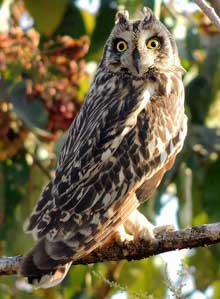
Short-eared Owl (Asio flammeus)
Length: 34-42cm
Wingspan: 90-105cm
UK pop.: 1,400 pairs
Short-eared owls prefer to hunt in open moorland, heath and marsh. Often seen during daylight, they hunt in a similar way to barn owls, quartering and hovering over the ground in search of prey. More research is required to establish the approximate number of short-eared owls in Britain. The population greatly increase during winter with the arrival of over-wintering birds from the Continent. Main diet consists of voles, however, they will feed on other small mammals if required. The short-eared owl will nest in a ground scrape, usually in tall vegetation.
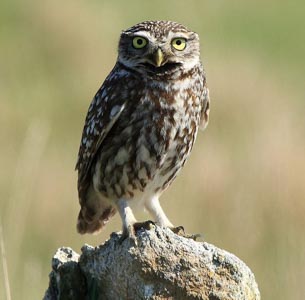
Little owl (Athene noctua)
Length: 21-23cm
Wingspan: 54-58cm
UK pop.: 5,700 pairs
This unusual little owl was introduced into Britain in the 19th century. Mainly found in the South of England, the little owl is now being found as far north as Northumberland. Unusually, this owl is mainly a daylight hunter, taking large insects, worms, and small mammals. The little owl will even hunt small birds during breeding season. The little owl will nest in holes in walls and trees, and has been known to use abandoned rabbit burrows.
Annual Visitors

Osprey (Pandion haliaetus)
Length: 52-60cm
Wingspan: 145-170cm
UK pop.: 800 pairs
The most well-known of the annual visitors to Britain. Persecuted to extinction in the early 1900's, a pair of ospreys re-appeared in Scotland in the late 1950's, and bred successfully. Since then, breeding pair numbers have grown, and the species has become more widespread throughout Britain. The Osprey winters in Africa, returning each year to the same nesting site. Feeding on an exclusive diet of fish, the osprey will build its nest in a large tree, close to an abundant supply of food.
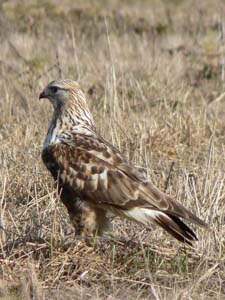
Rough-legged buzzard (Buteo lagopus)
Length: 50-60cm
Wingspan: 120-150cm
UK wintering: 10-30 pairs
Normally a resident of the northern tundra, this bird gets its name from the feathering on its legs. Rough-legged buzzards arrive on the Eastern side of Britain during October and November. In Britain, these birds prefer moorland, wetland, farmland and dunes. Used to eating a diet of lemmings, they will hunt small and medium sized mammals.
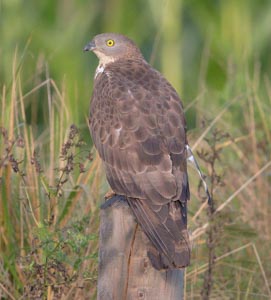
Honey buzzard (Pernis apivorus)
Length: 52-60cm
Wingspan: 135-150cm
UK pop.: 40 pairs
Wintering in Africa, the honey buzzard visits Britain from April to August to breed. The honey buzzard does not eat honey, but feeds on the larvae of wasps and bees. Evolution has provided the tools to enable this bird to cope with stings, hard scaly feathers on the head, and to extract the larvae from the nest. The honey buzzard will rely on a substitute diet of small mammals, birds, eggs, and fruit, if required. The nests of the honey buzzard are built in tall conifers.
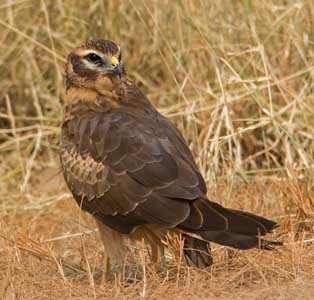
Montagu's harrier (Circus pygargus)
Length: 43-47cm
Wingspan: 100-120cm
UK pop: Less than 5 pairs
The Montagu's harrier is an occasional breeding visitor to Britain and its status is precarious. Its habitat is limited to the Southwest of Britain. Usually resident from April to September, preferring marshes, dunes and heath-land. Nests on the grass, usually in tall vegetation. A varied diet consists of small mammals, songbirds, reptiles, amphibians, chicks and eggs.
Occasional Visitors
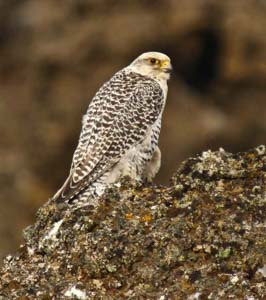
Gyrfalcon (Falco rusticolus)
Length: 48-65cm
Wingspan: 110-160cm
Only the white gyrfalcon from Greenland and Canada has been seen in Britain, in the Northern Isles. The gyr is the largest of the falcon family. This powerful bird is capable of taking down geese and seabirds. In the tundra, the gyr will nest on rocky ledges.
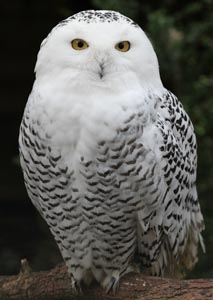
Snowy owl (Bubo scandiacus)
Length: 52-71cm
Wingspan: 125-150cm
The snowy owl is a large owl with dense feathers, capable of withstanding very low temperatures. A very rare visitor, between 1967 and 1975, snowy owls bred on the remote Island of Fetlar in the Shetland Isles north of Scotland. Their status in the British Isles is now that of a rare winter visitor. In the Arctic tundra the main diet is lemmings, however, this strong hunter will feed on shrews, rabbits, voles, geese and seabirds. The snowy owl will build its nest on rocky outcrops in the tundra.
